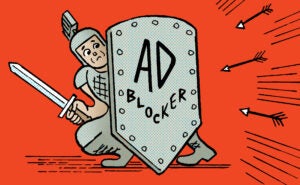 Here’s today’s AdExchanger.com news round-up… Want it by email? Sign-up here.
Here’s today’s AdExchanger.com news round-up… Want it by email? Sign-up here.
Small Victories
Ad blocking in Germany has declined roughly 2% since Q3 2015, according to one national digital media trade group. Ad-blocking trends always seem to start in Germany, so it could be a harbinger for other markets. Jack Marshall of The Wall Street Journal explores the possibility that ad-block declines are due to harsher publisher stances against ad blockers. German pub Axel Springer, for example, took Adblock Plus to court in February regarding its paid whitelisting model. Meanwhile, eMarketer reports that mobile ad blocking is rare. Only 2% of US consumers have ad blockers installed on their smartphones, compared with 23% on desktop, according to research from AudienceProject. More.
Blink Of An Eye
Advertisers aren’t quite sure how to feel about Snapchat’s average video view time of less than three seconds. Snapchat has been helping brands and agencies create content that fits its ephemeral, short-form video messaging platform, but that hasn’t stopped users from skipping ads (which the platform allows). “The interstitial vertical video ad is challenging,” a social media agency executive anonymously told Garett Sloane of Ad Age. “People just tap through. That’s the behavior.” Concerns about video view time won’t stop advertisers from buying on the platform, however, as it connects them to an elusive, young audience raised on mobile. Still, Snapchat will have to prove the effectiveness of its video ads against rivals like Facebook as it seeks an IPO in 2017. More.
You Down With OTT?
Monday was a big day for streaming media on the long road to TV integration. Bloomberg reported that Hulu, which as a joint venture between Disney, Comcast, 21st Century Fox and Time Warner toes the line with broadcasters, debuted “a plan to become the first streaming service to couple live TV with a wide library of on-demand programs.” More. AT&T finally unveiled its OTT service, DirecTV Now, combining its cable infrastructure with DirecTV, a $49 billion acquisition last year. If AT&T’s $85 billion Time Warner takeover clears regulatory review, that will only complicate matters. Meanwhile, Dish’s Sling TV and Roku are beta testing a cloud DVR product that will let users record and store up to 100 hours of TV. Netflix and Amazon maintain an iron grip on OTT viewership, but when Dish (with a $26 billion market cap) is one of the smaller competitors looking to challenge your position, no Goliath can take its position for granted.
Unreal
Facebook is a prominent distributor of online news, including the fake variety. Analytics company Jumpshot tracked Facebook referrals from more than 20 news sites from September to November, finding 80% of unique visitors to hyperpartisan news sites came from the platform, Poynter reports. Fake news site abcnews.com.co can attribute 60% of total visits to Facebook during that period. Compare that to The New York Times and CNN, which attribute 20% and 11% of site visits to Facebook, respectively. Even as they’re cut from Facebook and Google exchanges, fake news sites are finding new purchase in content recommendation widgets like Taboola and Revcontent, which manufacture scale through long-tail networks.
Blame The Ref
ComScore is in the crosshairs of media sellers and buyers alike. Publishers begrudge “the comScore haircut” and ad buyers now often come with their own tools for evaluating media. “ComScore acts, it says, in the best interests of both publishers and agencies,” writes Shareen Pathak at Digiday. But satisfying all parties is increasingly difficult (except maybe for Google or Facebook, where marketers are forced to accept media grading its homework). “We’re the referees. Our business is being predicated on being trusted by both sides,” says Andrew Lipsman, comScore’s VP of insights. The thing is, how often do both teams end up happy with the referees? More.
But Wait, There’s More!
- Adland Overly Worships At The Altar Of Youth – Campaign
- ComScore Improperly Records Revenue Again – WSJ
- Adblock Plus Fends Off Yet Another Publisher Lawsuit In Germany – blog
- CNN To Launch A New Media Company With YouTube Star – Adweek
- Western Media Group Takes On Triton’s a2x Audio Exchange In Canada – release
- AT&T Remained On The Sidelines Over Black Friday – FierceWireless
- Dentsu Acquires Bluecom Group, Rebrands As Isobar Commerce – release
- In Europe, Is Uber A Transportation Service Or Digital Platform? – NYT
- Dick’s Sporting Goods Acquires GameChanger Media – TechCrunch
You’re Hired!
- Nada Stirratt Is Out As Verve CEO – GeoMarketing
- Tapad Appoints Igor Elbert As Data Science Lead – release
- Ex-AwesomenessTV Exec Steve Woolfe Is Go90 Head Of Programming – Variety
- PulsePoint Hires Chris Neuner As SVP & GM Digital Health Solutions – release











